Partager

La Chaîne du Vivant - Chroniques de Biologie d'Yves Muller
20. D’un long confinement dans les entrailles de la terre aux rouages des horloges biologiques
Cette 20ème chronique démarre en été 1962, avec un spéléologue dénommé Michel Siffre, qui s'enfonce dans le noir du gouffre de Scarasson à la frontière franco-italienne. Et il va passer 60 jours seul dans les entrailles de la terre. Avec cette expérience d'isolement hors du temps, une nouvelle science vient de naître, la chronobiologie. Cette chronique présente ensuite les travaux qui ont permis le décryptage des mécanismes moléculaires de l’horloge biologique d’une petite mouche et qui ont valu à leurs auteurs le prix Nobel 2017 de physiologie. Les rouages des horloges biologiques des Mammifères sont ensuite abordés par comparaison avec ceux de la mouche, mettant en évidence l’existence d’un modèle de fonctionnement commun, mais faisant aussi apparaître des différences majeures, notamment dans le mode d’action de la lumière dans la synchronisation des horloges.
Auteur : Yves Muller – Professeur Agrégé de classe exceptionnelle - Docteur en Neurosciences - Université de Montpellier
From a long confinement in the bowels of the earth to the cogs of our biological clocks
Our 20th chronicle begins in summer 1962, with a speleologist named Michel Siffre, descending into the dark of the Scarasson abyss on the Franco-Italian border. He will spend 60 days alone in the bowels of the earth. Through this experience of timeless isolation, a new science is born, chronobiology. Our chronicle then presents the work that allowed for the decoding of the molecular mechanisms of the biological clock of a small fly and that won their authors the 2017 Nobel Prize in physiology. We then compare the workings of the biological clocks in Mammals with those of the fly, highlighting the existence of a common operating model, but also major differences, notably in the mode of action of light in clock synchronization.
Michel Siffre (1963) Hors du temps. Julliard
Konopka RJ, Benzer S. (1971) Clock mutants of Drosophila melanogaster. Proc Natl Acad Sci USA ; 68 : 2112–6.
Reddy P, Zehring WA, Wheeler DA, et al. (1984) Molecular analysis of the period locus in Drosophila melanogaster and identification of a transcript involved in biological rhythms. Cell ; 38 : 701-10.
Crews ST, Thomas JB, Goodman CS. (1988) The Drosophila single-minded gene encodes a nuclear protein with sequence similarity to the per gene product. Cell ; 52 : 143-51.
Hardin PE, Hall JC, Rosbash M. (1990) Feedback of the Drosophila period gene product on circadian cycling of its messenger RNA levels. Nature ; 343 : 536-40.
Hardin PE, Hall JC, Rosbash M. (1992) Circadian oscillations in period gene mRNA levels are transcriptionally regulated. Proc Natl Acad Sci USA ; 89 :11711-5
Zeng H, Hardin PE, Rosbash M. (1994) Constitutive overexpression of the Drosophila period protein inhibits period mRNA cycling. EMBO J ; 13 : 3590-8
Sehgal A, Price JL, Man B, Young MW. (1994) Loss of circadian behavioral rhythms and per RNA oscillations in the Drosophila mutant timeless. Science 263 : 1603-6
Vitaterna MH, King DP, Chang AM et al. (1994) Mutagenesis and mapping of a mouse gene, Clock, essential for circadian behavior. Science ; 264 :719-25
Price JL, Dembinska ME, Young MW, Rosbash M. (1995) Suppression of PERIOD protein abundance and circadian cycling by the Drosophila clock mutation timeless. EMBO J ; 14 : 4044-9
Allada R, White NE, So WV, et al. (1998) A mutant Drosophila homolog of mammalian Clock disrupts circadian rhythms and transcription of period and timeless. Cell ; 93 : 791-804
Emery P, So WV, Kaneko M, et al. (1998) CRY, a Drosophila clock and light-regulated cryptochrome, is a major contributor to circadian rhythm resetting and photosensitivity. Cell ; 95 : 669-79
Ameisen JC (2017) Les horloges circadiennes – Sur les épaules de Darwin - France Inter
More episodes
View all episodes
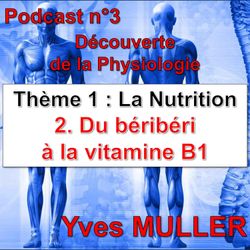
3. Du béribéri à la vitamine B1
28:36|Podcast 3 - Découverte de la PhysiologieThème 1 : La Nutrition - 2. Du béribéri à la vitamine B1Auteur : Yves Muller - Professeur Agrégé de classe exceptionnelle - Docteur en Neurosciences - Université de Montpellier - Département d’Enseignement et de Recherche : Biologie et Mécanismes du Vivant Sommaire :1. Introduction : 00:00 à 02:042. Quelques données historiques sur le béribéri : 02:04 à 06:443. Expérience d’Eijkman (1880) conduite sur des oiseaux : 06:44 à 13:144. Enquête épidémiologique de Vorderman (1887) sur le béribéri : 13:14 à 17:255. La vitamine B1 : de sa découverte à sa structure chimique : 17:25 à 20:116. La notion de vitamine : 20:11 à 21:267. Sources alimentaires de vitamine B1 : 21:26 à 22:248. Rôles de la vitamine B1 : 22:24 à 27:199. Présentation de la vidéo 4 : 27:19 à 28:36Version vidéo de ce podcast :https://youtu.be/tLZxa1MGSMs Bibliographie :- Cadet R. (2022). L’invention de la physiologie - 140 expériences historiques. Belin Éducation- Dedet J.-P. (2013). Culture historique pour l’UE7 - PACES. Ediscience- Delarue J. et coll. (2021). Nutrition - Enseignement intégré. Elsevier Masson- Lecref J.-M. (2012). Les 100 ans d’une vieille dame : la vitamine B1. Correspondances en Métabolismes Hormones Diabètes et Nutrition. 16(1-2):6-8- Marieb E. N. et Hoehn K. (2019). Anatomie et Physiologie humaine. Pearson- Quilliota D. et coll. (2018). Pratiques en nutrition - Déficit en vitamine B1 : comment prévenir et traiter. Société Francophone Nutrition Clinique et Métabolisme- Schlienger J.-L. et Monnier L. (2011). L’épopée de la découverte des vitamines. Médecine des Maladies Métaboliques. 5(6):593-597- Schlienger J.-L. (2018). Nutrition clinique pratique - Chez l’adulte, l’enfant et la personne âgée. Elsevier Masson- Silverthorn D. U. (2019). Physiologie humaine : Une approche intégrée. Pearson- Tortora G. et Derrickson B. (2022). Anatomie et physiologie humaines. De Boeck Supérieur- Voet D. et Voet J.G. (2016). Biochimie. De Boeck Supérieur- Widmaier E.-P., Raff H. et Strang K.-F. (2013). Physiologie humaine - Vander - Les mécanismes du fonctionnement de l'organisme. Maloine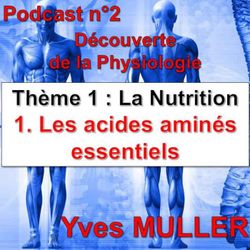
2. Les acides aminés essentiels
36:13|Podcast 2 : Découverte de la PhysiologieThème 1 : La Nutrition - 1. Les acides aminés essentielsAuteur : Yves Muller - Professeur Agrégé de classe exceptionnelle - Docteur en Neurosciences - Université de Montpellier - Département d’Enseignement et de Recherche : Biologie et Mécanismes du Vivant Sommaire :1. Introduction : 00:00 à 01:232. Les protéines sont des polymères d’acides aminés : 01:23 à 09:063. Expériences d’Osborne et Mendel (1916) sur les besoins nutritionnels de jeunes rats : 09:06 à 22:294. Les acides aminés essentiels : 22:29 à 24:515. La synthèse des protéines : 24:51 à 29:336. Protéines alimentaires complètes et incomplètes : 29:33 à 34:007. Les acides gras essentiels : 34:00 à 35:078. Présentation de la vidéo 3 : 35:07 à 36:13Version vidéo de ce podcast :https://youtu.be/e-Um4F4HrEA Bibliographie :- Cadet R. (2022). L’invention de la physiologie - 140 expériences historiques. Belin Éducation- Dedet J.-P. (2013). Culture historique pour l’UE7 - PACES. Ediscience- Delarue J. et coll. (2021). Nutrition - Enseignement intégré. Elsevier Masson- Marieb E. N. et Hoehn K. (2019). Anatomie et Physiologie humaine. Pearson- Schlienger J.-L. (2018). Nutrition clinique pratique - Chez l’adulte, l’enfant et la personne âgée. Elsevier Masson- Silverthorn D. U. (2019). Physiologie humaine : Une approche intégrée. Pearson- Tortora G. et Derrickson B. (2022). Anatomie et physiologie humaines. De Boeck Supérieur- Voet D. et Voet J.G. (2016). Biochimie. De Boeck Supérieur- Widmaier E.-P., Raff H. et Strang K.-F. (2013). Physiologie humaine - Vander - Les mécanismes du fonctionnement de l'organisme. Maloine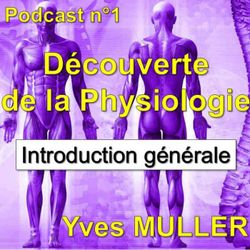
1. Découverte de la Physiologie - Introduction générale à la Physiologie
42:28|Podcast 1 - Découverte de la Physiologie - Introduction générale à la PhysiologieAuteur : Yves Muller - Professeur Agrégé de classe exceptionnelle - Docteur en Neurosciences - Université de Montpellier - Département d’Enseignement et de Recherche : Biologie et Mécanismes du Vivant Sommaire :1. Introduction : 00:00 à 01:022. Savoir regarder en arrière : 01:02 à 02:443. La Physiologie, une étude du fonctionnement de l’organisme : 02:44 à 03:594. D’Hippocrate à Claude Bernard : 03:59 à 13:055. Les niveaux d’organisation du vivant : 13:05 à 19:336. Les grandes fonctions et les systèmes : 19:33 à 32:397. La démarche expérimentale : 32:39 à 39:198. Plan général du cours complet : 39:19 à 41:279. Présentation du podcast 2 : 41:27 à 42:28Version vidéo de ce podcast :https://youtu.be/pFp4jLOUfjU Bibliographie :- Bernard C. (1865). Introduction à la médecine expérimentale. Flammarion, 1984- Brooks H. (2012). Physiologie médicale. De Boeck Supérieur- Cadet R. (2022). L’invention de la physiologie - 140 expériences historiques. Belin Éducation- Dedet J.-P. (2013). Culture historique pour l’UE7 - PACES. Ediscience- Cornec J.-P. (2016). Physiologie animale. De Boeck Supérieur- Marieb E. N. et Hoehn K. (2019). Anatomie et Physiologie humaine. Pearson- Silverthorn D. U. (2019). Physiologie humaine : Une approche intégrée. Pearson- Tortora G. et Derrickson B. (2022). Anatomie et physiologie humaines. De Boeck Supérieur- Widmaier E.-P., Raff H. et Strang K.-F. (2013). Physiologie humaine - Vander - Les mécanismes du fonctionnement de l'organisme. Maloine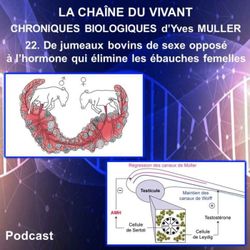
22. 22. De jumeaux bovins de sexe opposé à l’hormone qui élimine les ébauches femelles
53:01||Ep. 2222. De jumeaux bovins de sexe opposé à l’hormone qui élimine les ébauches femellesDans cette chronique, vous croiserez 2 faux jumeaux bovins de sexe opposé, des lapins géants des Flandres, une lapine blanche baptisée Céleste et une famille dont les 3 fils possèdent un utérus. Ces rencontres vous permettront de découvrir une étonnante histoire scientifique qui a conduit à la caractérisation d’une nouvelle hormone impliquée dans la différenciation sexuelle. Quel que soit son sexe génétique, l’embryon de Mammifère possède 2 canaux de Wolff et 2 canaux de Müller. Si l’embryon est de sexe génétique mâle, les 2 canaux de Müller vont régresser tandis que les 2 canaux de Wolff seront maintenus et formeront les voies génitales mâles sous l’influence de la testostérone produite par le testicule fœtal. Si l’embryon est de sexe génétique femelle, les 2 canaux de Wolff vont régresser tandis que les 2 canaux de Müller seront maintenus et ils formeront les voies génitales femelles. Cette chronique présente les travaux d’Alfred Jost publiés en 1947 et qui lui ont permis d’affirmer que la testostérone n’était pas la seule hormone produite par le testicule fœtal, mais qu’il devait exister une autre hormone responsable de la régression des canaux de Müller. Puis vous verrez que le travail acharné et passionné de Nathalie Josso lui a permis en 1984 d’isoler cette nouvelle hormone testiculaire, qu’elle a nommé Hormone anti-Müllerienne ou AMH. La suite de cette histoire scientifique révèlera que l’AMH est produite aussi par l’ovaire et le dosage sanguin de l’AMH chez la femme permet aujourd’hui d’évaluer les chances de fertilité féminine. Vous verrez aussi que la découverte de l’AMH a permis de comprendre pourquoi dans certaines familles, les garçons ont un utérus.Errata : - à 5'02, l'année où Wolff découvre les reins primitifs est 1780 et non 1880. - à 13'09, il faut préciser que Leydig a découvert les cellules qui portent son nom en 1857, soit 8 ans avant la découverte par Sertoli en 1865 des cellules qui portent son nom. Auteur : Yves Muller - Professeur Agrégé de classe exceptionnelle - Docteur en Neurosciences - Université de Montpellier Références :- Keller K et Tandler J (1916) The behaviour of the chorion in twin pregnancies of cattle - Wien. Tierärztl. Monatsschr ; 3:513-16.- Lillie FR (1917) The freemartin, a study of the action of sex hormones in foetal life of cattle - J. Exp. Zool. ; 23:371-452.- Picon R (1969) Action du testicule foetal sur le développement in vitro des canaux de Müller chez le rat – Arch. Anat. Micros. Morph. Exp ; 58:1-19.- Jost A et coll. (1972) Becoming a male - Adv. Biosci ; 10:3-13.- Josso N (1973) In vitro synthesis of Müllerian-inhibiting hormone by seminiferous tubules isolated from the calf fetal testis – Endocrinology ; 93:829-34.- Picard JY et Josso N (1984) Purification of testicular anti-Müllerian hormone allowing direct visualization of the pure glycoprotein and determination of yield and purification factor -Molecular and Cellular Endocrinology ; 34:23-29.- Behringer RR et coll. (1990) Abnormal sexual development in transgenic mice chronically expressing Müllerian inhibiting substance – Nature ; 345:167-70.- Knebelmann B et coll. (1991) Anti-Müllerian hormone Bruxelles : a nonsense mutation associated with the persistent Müllerian duct syndrome – PNAS USA ; 88:3767-71.- Racine C et coll. (1998) Receptors for anti-mullerian hormone on Leydig cells are responsible for its effects on steroidogenesis and cell differentiation. PNAS USA ; 95:594-99.- Durlinger AL et coll. (1999) Control of primordial follicle recruitment by anti- Mullerian hormone in the mouse ovary ; Endocrinology ; 140:5789-5796.- Josso N (2017) Le Sexe des Anges : Une histoire d'hormones - EDP Sciences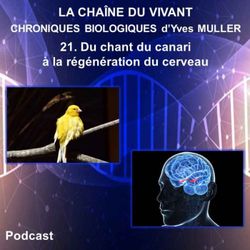
21. 21. Du chant du canari à la régénération du cerveau (nouvelle version)
35:57||Ep. 21Cette chronique démarre par le chant de séduction qu’émet le canari mâle au printemps et que cet oiseau chanteur va modifier chaque année. Vous croiserez ensuite le Dieu Pan jouant de la flûte, des mésanges cachant des graines, des souris qui apprennent et mémorisent, des chauffeurs de taxi de la ville de Londres et des essais nucléaires pendant la guerre froide. Cette chronique vous conduira à découvrir que le cerveau des oiseaux et des mammifères adultes est pourvu d’une capacité de régénération. Et peut-être parviendrons-nous un jour à stimuler la production de neurones dans notre cerveau pour faire face à des lésions cérébrales ou des maladies neurodégénératives.Auteur : Yves Muller - Professeur Agrégé de classe exceptionnelle - Docteur en Neurosciences - Université de Montpellier21. Biological Chronicles - From the song of the canary to the regeneration of the brainOur chronicle begins with the seduction song the male canary emits in spring and which this songbird will modify each year. We will then encounter the God Pan playing the flute, chickadees hiding seeds, mice with learning and memorizing capabilities, London taxi drivers and nuclear tests during the Cold War. Our chronicle leads us to then to the discovery that the brains of adult birds and mammals have a capacity for regeneration. And maybe we’ll one day be able to stimulate the production of neurons in our brain to deal with brain damage or neurodegenerative diseases. From a fly with legs on its head to the discovery architectural genesAuthor : Yves Muller – Associate Professor at Montpellier UniversityRéférences :- Messier B, Leblond CP, Smart I (1958) Presence of DNA synthesis and mitosis in the brain of young adult mice - Experimental Cell Research ; 14:224–6- Altman J et Das GD (1965) Autoradiographic and histological evidence of postnatal hippocampal neurogenesis in rats - Journal of Comparative Neurology ; 124:319-35- Nottebohm F, Stokes TM, Leonard CM (1976) Central control of song in the canary, Serinus canaria - Journal of Comparative Neurology ; 165: 457–86- Nottebohm F (1981) A brain for all seasons: cyclical anatomical changes in song control nuclei of the canary brain - Science ; 214:1368-70- Paton JA et Nottebohm FN (1984) Neurons generated in the adult brain are recruited into functional circuits – Science ; 225:1046-8- Nottebohm F (1989) From Bird Song to Neurogenesis - Scientific American ; 260:74-9- Alvarez-Buylla A, Theelen M et Nottebohm F (1990) Proliferation “hot spots” in adult avian ventricular zone reveal radial cell division – Neuron ; 5:101–9- Kirn J, O’Loughlin B et coll. (1994) Cell death and neuronal recruitment in the high vocal center of adult male canaries are temporally related to changes in song - PNAS USA ; 91:7844-8- Barena A et Nottebohm F (1994) Seasonal recruitment of hippocampal neurons in adult free-ranging black-capped chickadees - PNAS USA ; 91:11217-21- Eriksson PS, Perfilieva E et coll. (1998) Neurogenesis in the adult human hippocampus - Nature Medicine ; 4:1313-7- Taupin P (2005) Neurogenesis in the pathologies of the nervous system - Medecine Sciences 21:711-4- Nottebohn F (2005) The neural basis of birdsong – PloS Biology ; 3:e164,759-61- Rapanelli M, Frick L et Zanutto B (2011) Learning an operant conditioning task differentially induces gliogenesi in the medial prefrontal cortex and neurogenesis in the hippocampus - PLoS One 2011 ; 6:e14713, 1-12- Woollett K et Maguire E (2011) Acquiring “the Knowledge” of London's layout drives structural brain changes - Current Biology ; 21:2109-14- Bergmann O, Liebl J et coll. (2012) The age of olfactory bulb neurons in humans – Neuron ; 74:634-9- Alonso M, Lepousez G et coll. (2012) Activation of adult-born neurons facilitates learning and memory - Nature Neuroscience ; 15:897-904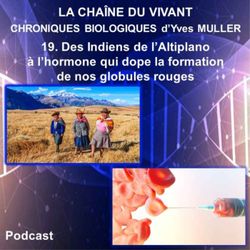
19. 19. Des Indiens de l’Altiplano à l’hormone qui dope la production de nos globules rouges
35:56||Ep. 19Cette 19ème chronique démarre sur l’Altiplano, où vivent des populations andines adaptées à la haute altitude, et donc exposées à une hypoxie chronique. Le sang des andins contient un nombre de globules rouges supérieur à celui des populations qui vivent au niveau de la mer. Cette chronique explique ensuite comment le manque d’oxygène en altitude conduit à la production par les reins de l’érythropoïétine (ou EPO), une hormone de nature protéique qui stimule la production des globules rouges. Les mécanismes moléculaires qui permettent à l’hypoxie d’activer l’expression de gènes, tel que le gène de l’EPO, sont présentés à partir des résultats des 3 chercheurs qui ont obtenu en 2019 le Prix Nobel de Physiologie ou de Médecine. Et la compréhension de ces mécanismes qui permettent aux cellules de s’adapter aux apports variables d’oxygène offrent de nouvelles perspectives pour lutter contre l’anémie et le cancer. Auteur : Yves Muller – Professeur Agrégé de classe exceptionnelle - Docteur en Neurosciences - Université de Montpellier19. Biological Chronicles - From the Altiplano Indians to the hormone that boosts the production of red blood cellsOur 19th chronicle begins on the Altiplano, hope to Andean populations who have adapted to high altitude, and are therefore exposed to chronic hypoxia. Andean blood contains a higher number of red blood cells than that of people living at sea level. Our chronicle then explains how lack of oxygen at high altitudes leads the kidneys to produce erythropoietin (or EPO), a protein hormone that stimulates the production of red blood cells. The molecular mechanisms that allow hypoxia to activate the expression of genes, such as the EPO gene, are presented based on the results of 3 researchers who won the 2019 Nobel Prize in Physiology or Medicine. Understanding the mechanisms which allow cells to adapt to variable oxygen supplies offers new perspectives in the fight against anemia and cancer.Références :- Semenza, G.L, Nejfelt, M.K., Chi, S.M. & Antonarakis, S.E. (1991). Hypoxia-inducible nuclear factors bind to an enhancer element located 3’ to the human erythropoietin gene. Proc Natl Acad Sci USA, 88, 5680-5684- Wang, G.L., Jiang, B.-H., Rue, E.A. & Semenza, G.L. (1995). Hypoxia-inducible factor 1 is a basic-helix-loop-helix-PAS heterodimer regulated by cellular O2 tension. Proc Natl Acad Sci USA, 92, 5510-5514- Maxwell, P.H., Wiesener, M.S., Chang, G.-W., Clifford, S.C., Vaux, E.C., Cockman, M.E., Wykoff, C.C., Pugh, C.W., Maher, E.R. & Ratcliffe, P.J. (1999). The tumour suppressor protein VHL targets hypoxia-inducible factors for oxygen-dependent proteolysis. Nature, 399, 271-275- Ivan, M., Kondo, K., Yang, H., Kim, W., Valiando, J., Ohh, M., Salic, A., Asara, J.M., Lane, W.S. & Kaelin Jr., W.G. (2001) HIFa targeted for VHL-mediated destruction by proline hydroxylation: Implications for O2 sensing. Science, 292, 464-468- Jaakkola, P., Mole, D.R., Tian, Y.-M., Wilson, M.I., Gielbert, J., Gaskell, S.J., von Kriegsheim, A., Heberstreit, H.F., Mukherji, M., Schofield, C.J., Maxwell, P.H., Pugh, C.W. & Ratcliffe, P.J. (2001). Targeting of HIF-α to the von Hippel-Lindau ubiquitylation complex by O2-regulated prolyl hydroxylation. Science, 292, 468-472- A. Bigham A, M. Bauchet et al. (2010) - Identifying signatures of natural selection in Tibetan and Andean populations using dense genome scan data - PLOS Genetics 6 (9)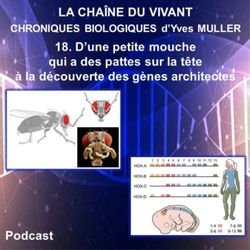
18. 18. D’une petite mouche qui a des pattes sur la tête à la découverte des gènes architectes
43:39||Ep. 18Cette 18ème chronique démarre par une étrange petite mouche pourvue de pattes sur la tête à la place des antennes. Il s’agit d’un mutant de drosophile appelé Antennapedia. Un autre mutant de drosophile, appelé Ultrabithorax, présente 2 paires d’ailes et non une seule. Et l'étude approfondie de tels mutants va permettre de découvrir les gènes homéotiques Hox, dont le fonctionnement détermine le plan du corps de la drosophile. La découverte de ces gènes architectes chez la petite mouche va permettre d’identifier chez les Vertébrés des gènes homéotiques Hox, apparentés à ceux de la drosophile, et qui déterminent le plan du corps des Vertébrés ainsi que la formation de leurs membres. Les gènes Hox, présents chez tous les animaux pluricellulaires, codent pour des facteurs de transcription à homéodomaine qui contrôlent le développement en régulant des réseaux de gènes impliqués dans la structuration du corps. Et ces gènes Hox architectes du plan du corps ont dû jouer un rôle fondamental dans l'évolution et la diversification des animaux segmentés. Auteur : Yves Muller – Professeur Agrégé de classe exceptionnelle - Docteur en Neurosciences - Université de Montpellier18. Biological Chronicles - From a fly with legs on its head to the discovery architectural genesOur chronicle begins with a strange little fly with legs on its head instead of antennae. It is a Drosophila mutant known as Antennapedia. Another Drosophila mutant, Ultrabithorax, has 2 pairs of wings instead of one. The in-depth study of such mutants will bring about the discovery of homeotic Hox genes, whose general function is to determine the body plan of Drosophila. The discovery of these architectural genes in the small fly will make it possible to identify homeotic Hox genes in vertebrates related to Drosophila as well. The Hox genes determine the body plan of vertebrates and also the formation of their members. The Hox genes, present in all multicellular animals, encode homeodomain transcription factor proteins which control development by regulating gene networks involved in the structural organization of the body. These Hox genes, architects of the body plan, must have played a fundamental role in the evolution and diversification of segmented animals. Références : - Bateson W (1894) Materials for the study of variation, treated with especial regard to dis-continuity in the origin of species – Londres, MacMillan and Co- Lewis EB (1978) A gene complex controlling segmentation in Drosophila – Nature ; 76:565-70- Nüsslein-Volhard C et Wieschaus E (1980) Mutations affecting segment number and polarity in Drosophila - Nature ; 287:795-801- Bender W et coll. (1983) Molecular genetics of the bithorax complex in Drosophila melanogaster – Science ; 221:23-9- Scott MP et Weiner AJ (1984) Structural relationships among genes that control development: sequence homology between the antennapedia, ultrabithorax, and fushi tarazu loci of Drosophila – PNAS USA ; 81:4115-9- McGinnis W et coll. (1984) A conserved DNA sequence in homoeotic genes of the Drosophila Antennapedia and bithorax complexes - Nature ; 308:428–33- Carrasco A et coll. (1984) Cloning of an X. laevis gene expressed during early embryogenesis coding for a peptide region homologous to Drosophila homeotic genes - Cell ; 37:409-14- François Jacob (1994) L’irrésistible ascension des gènes Hox – Médecine Sciences ; 10 :145-8- Denis Duboule (2007) The rise and fall of Hox gene clusters - Development ; 134:2560- Wellik DM (2009) Hox genes and vertebrate axial pattern - Curr Top Dev Biol ; 88:257-78- Mallo M et coll. (2010) Hox genes and regional patterning of the vertebrate body plan - Dev Biol ; 344:7-15 - Gaunt SJ (2018) Hox cluster genes and collinearities throughout the tree of animal life - The International Journal of Developmental Biology ; 62: 673–83
17. 17. Du cyclope légendaire au rôle du fœtus dans le déclenchement de l’accouchement
32:58||Ep. 17Cette 17ème chronique biologique démarre par une première histoire contée par Homère dans l’Iliade et qui oppose le héros Ulysse au cyclope Polyphème. Et dans cette histoire mythologique, ce sont des moutons qui vont aider Ulysse à s’échapper de l’antre du cyclope. Puis cette chronique raconte une seconde histoire, véridique cette fois, dans laquelle on parle aussi de moutons et de cyclopes, mais aussi de la petite mouche du vinaigre puis de Sonic le hérisson, personnage célèbre de jeux vidéo. Cette seconde histoire nous amène à décrire les mécanismes qui permettent à la brebis de mettre bas, en montrant que c’est le fœtus lui-même qui va déclencher la mise bas. Puis les mécanismes déclenchant l’accouchement chez la femme sont également abordés, par comparaison avec la brebis. Cette chronique nous conduit donc étonnamment du cyclope au mécanismes de l’accouchement, mais elle nous amène de façon tout aussi surprenante à de nouvelles pistes médicamenteuses pour lutter contre certains cancers. Auteur : Yves Muller – Professeur Agrégé de classe exceptionnelle - Docteur en Neurosciences - Université de Montpellier17. Biological Chronicles - From the legendary cyclops to the role of the fetus in the onset of childbirth.This biological chronicle begins with a story told by Homer in the Iliad which pits the hero Ulysses against Cyclops Polyphemus. In this mythological story, Ulysses is helped to escape from the cave of the Cyclops by sheep. Then, our chronicle will tell a second story, true this time, which is also about sheep and cyclops, but also about tiny vinegar flies and Sonic the hedgehog (famous video game character). This second story leads us to the mechanisms that allow sheep to give birth, showing that it is the fetus itself that triggers the start of labor. The mechanisms triggering childbirth in women are also discussed, in comparison to sheep. This chronicle thus brings us surprisingly from the cyclops to the mechanisms of childbirth, but it brings us just as surprisingly to new treatment possibilities in the fight against certain cancers. Références : - I only have eye for ewe: the discovery of cyclopamine and development of Hedgehog pathway-targeting drugs – Chen JK - Nat Prod Rep. 2016 May 4;33(5):595-601- Cyclopamine and Hedgehog Signaling: Chemistry, Biology, Medical Perspectives - Philipp Heretsch Lito Tzagkaroulaki, Athanassios Giannis – 2010 - Angewandte Chemie International Edition/Volume 49, Issue 20